I’ve just spent a fascinating couple of days at Riesling Down Under. A celebration of Riesling with producers from around the world attending. Whilst devouring loads of seriously good juice, we had the opportunity to explore the different styles of Riesling, from clean, pure, dry styles, to those with a bit more attitude, driven by skin contact, barrel fermentation & maturation, pretty much anything you could do to a white wine.
While the debate often headed down the line of what a typical Riesling should be in a particular Riesling growing region of the world, and, how to ensure site is expressed, I found myself returning to the old favourites to assess the wines: depth and length of flavour and aroma, balance, complexity, texture, and, freshness with good pre-bottling development. Most importantly harmony and a style that showed personality.
If you listen carefully to the glass you’ll hear the good ones whispering ‘DRINK ME! DRINK ME!’
“Few estates in the world can claim to have maintained the highest quality standards uninterrupted for half a century and more. Joh Jos Prüm, the most famous of the many Mosel wine estates bearing the Prüm name, is one estate that can. Since the early 1920’s its wines have been among Germany’s best, Rieslings with the Mosel’s vivacious aroma and racy elegance in its highest form.” Stuart Pigott, The Wine Atlas of Germany
Dry vs Including Sugar
One of the talking points paid most attention was the differences between dry styles, containing no sugar 2 grams per litre or less, and, sweeter styles that contained significant levels of grape sugar, up to 60g grams per litre and beyond. To put that into context, coke has 106g/L. Dessert styles such as the Beerenauslese and Trockenbeerauslese were a separate discussion.
There were estates working more dominantly at one end of the spectrum, and, those with a range of wines across the spectrum. It was clear that all were experimenting, in both the winery and less so in the vineyard, some much more than others. The end call was always the same, make the best possible wine they could, from the grapes they had. This was true across, Australia, South Africa, New Zealand, France, Germany and Austria.
The most extreme example of experimentation being run by Johannes Hasselbach from Gunderloch, in this case for dry Riesling. Wurzelwerk (“Rootwork”) project exploring the concepts of soil, home and Riesling. Four winemakers from three wineries are involved: Johannes plus Stefanie and Alwin Jurtschitsch from the Kamptal in Austria and Max von Kunow of Weingut von Hövel in the Saar. They all exchanged a portion of their harvest in 2012 with the motto, “Give me your juice; I’ll give you mine”. Grapes from their superb vineyards were vinified similarly with minimal intervention (spontaneous fermentation in stainless steel) in three separate cellars, each with a personal interpretation. The result, a disruptive, exchange of thought, and stimulation of what could be next!
The German System
Wow, even the most dedicated wine geek often has trouble getting their head around the German naming systems, something they’ve been working on simplifying!
When it comes to wines containing some level of grape sugar, the Germans have a classification that dictates ranges of sugar levels grapes for a specific wine must be picked at, in essence establishing a framework for the ripeness, amount of Bortytis and shrivel / raisoning the fruit should have when picked. The amount of grape sugar left in the wine after it has fermented, is up to the maker.
All of this super detailed information is interesting to know.
At the end of the day the most important thing is whether the wine meets those standard criteria for good wine. During Riesling Down Under it was great to hear winemakers from around the world, all saying they don’t care much for the numbers, they picked their fruit on flavour and made their wines to achieve balance and harmony.
The following is courtesy of Dr Loosen, who sums up German Riesling styles with sweetness beautifully
The Versatility of Riesling
Riesling is one of the few grapes that is capable of producing a complete spectrum of wine styles, from bone dry to lusciously sweet. The key to maintaining top quality throughout this broad range lies in a rigorous selection process. As the harvest progresses, we make daily decisions about each vineyard parcel based on the maturity of the fruit and the prevailing weather conditions. Healthy grapes are painstakingly separated from botrytis-affected fruit, and the various selections are vinified separately.
Classic Wines with Sweetness
Our traditional wines, with residual sweetness, are selected from the harvest according to their ripeness and flavour development. The finest lots from our classified vineyards are bottled with their corresponding single-vineyard name and ripeness (Prädikat) level. For the non-botrytis wines, there are two Prädikat levels, Kabinett and Spätlese.
Beyond the lightly sweet Kabinett and Spätlese bottlings, made without botrytis, there are three Prädikat levels of botrytis-selection wines that get progressively sweeter: Auslese, Beerenauslese [berry selection] and Trockenbeerenauslese [dried berry selection]. In addition, when vintage conditions allow it, we produce Eiswein from grapes that have frozen on the vine.
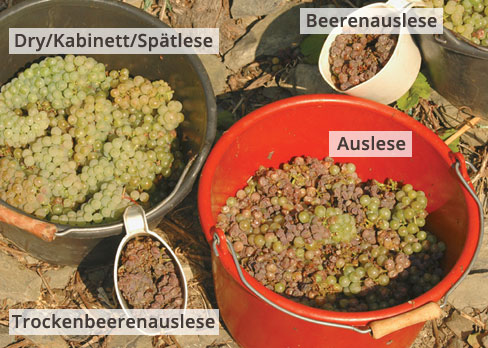
The picture from Dr Loosen above is a great illustration of the different conditions of grapes at harvest and the styles they are destined to make. You can see the level of Botrytis and shrivel / raisining increasing as we move through the styles from Kabinett to Trockenbeerenauslese. The Botrytis or Noble Rot, imparts wonderful flavours and textures to the wine, and is to be revered like the blue moulds of Rocquefort and the washed rind cheeses of Munster in Alsace, appropriately both cheeses marry beautifully with a glass of Riesling.
Note how the buckets are colour coded according to the end destination of the fruit and how little of the Trockenbeerenauslese is produced. The skill of pickers and willingness to pass through the vineyard several times to ensure all grapes are picked at the optimal time is the key to success.
The freshest style is Kabinett and as you move up the scale you’ll see additional complexity added by botrytis and other winemaking influences in addition to greater levels of sweetness. Each style whether Kabinett or Eiswein being perfect for consumption on different occasions with different foods. The Beerenauslese, Trockenbeerenauslese, and, Eiswein being exceptional dessert wines. Kabinett and Spätlese being suited to table wine consumption. The standard line for the German’s being that where the English offer tea to guests in the afternoon the German’s offer Kabinett or Spätlese wines, more akin to a table wine. That said I devoured a Wagner-Stemple Kabinett, with pasta and cheese on a 38°C day in Melbourne, perfection! Auslese sitting on either side depending on the style the estate makes.
This intense sorting process is beautifully articulated by Ernie Loosen from 2min 25sec in the vineyard below.
Prüm is an estate that prides itself in making beautifully balanced wines, no matter what the sugar level, that age incredibly well.
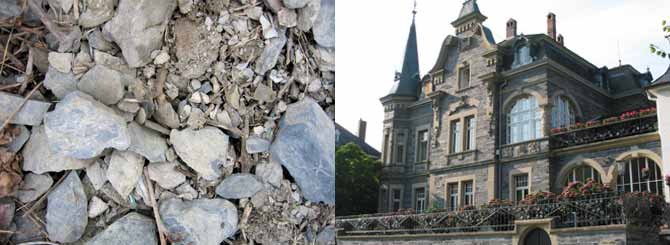
In 1993 I was hoovering bottles of Prüm, Spatlese and Auslese from 1983. All were still fresh and vibrant, yet, they had settled beautifully, showing great poise. These wines are from climates that often deliver bracing natural acidity. For the wine techies, pH is ofter 2.9-3.0, lower than, but, not far off Champagne, and, loads higher than Coke at a pH of 2.4. Again all the detail is irrelevant, the balance, poise and harmony in the glass being what really matters.
If you have any doubt about just how good these wines are, read this extract, from the article ’10 Things every wine lover should know about JJ Prüm’ by Stuart Piggot.
Take a look at Wine-Searcher’s summary of the world’s 50 most expensive wines, and you’ll find that none has as many white wines listed as Weingut Joh. Jos. Prüm. This estate, located in the village of Wehlen in Germany’s Mosel wine region, is also known to wine lovers around the world as “J.J. Prüm”, or simply “J.J.”
Its Riesling Trockenbeerenauslese (TBA) takes sixth place in the most-expensive list, with an average price of $5647. At #32 is the estate’s Riesling Beerenauslese (BA), and the Riesling Eiswein is at #43. All of these wines are from the famous Wehlener Sonnenuhr vineyard site.
Recent auction results at Zachy’s give an idea of J.J. Prüm’s desirability. In September, 12 bottles of 1983 Wehlener Sonnenuhr Riesling Auslese “Gold Cap” sold for $2450, and at the La Paulée auction in March two lots of 3 bottles of 1959 Wehlener Sonnenuhr Riesling TBA each went for $15,925.
What makes this achievement all the more remarkable is the fact that as a category, sweet whites still struggle to gain the popular recognition which experts accord them, and all the “J.J.” wines stand out for their finesse and delicacy rather than their power.
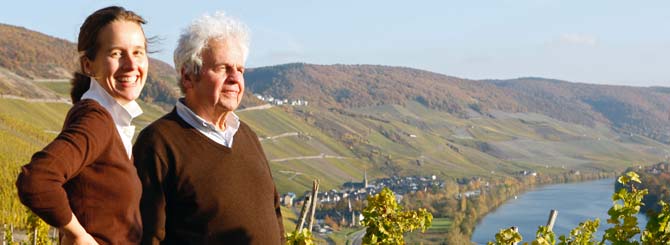
“The wines, whether a modest Kabinett or an opulent Beerenauslese, are the epitome of filigree elegance: light in body but intense in flavour, exquisitely balanced and precisely tuned, and capable of the most extra-ordinary longevity. With the rise of so many excellent winemakers in the region, one might have supposed that J.J. Prüm, with its profound conservatism, might have been overtaken and left behind. Not a bit of it. The Estate remains where it has been for decades: at the summit.” Stephen Brook, The Wines of Germany, Mitchell Beazley
The Prüm Estate
The film below explores aspects of Prüm with the 2013 Vintage as context. Although not the year we are offering there are some worthwhile insights shared.
The Mosel River Valley is probably the most famous and arguably the most admired wine region in Germany. In its wider sense, it includes the adjacent Saar and Rüwer (hence Mosel-Saar-Rüwer), both tributaries of the Mosel River, however, it is the middle Mosel (mittelmosel), in particular between and including the towns of Bernkastel-Kues and Erden that the most brilliant wines tend to be produced. Bernkastel, Grach, Wehlen, and Zeltingen are some of the most famous wine towns here. All of the vineyards of J.J. Prüm are located within this prestigious strip. The Prüm family history in the Mosel dates back as early as 1156! However, Johann Josef Prüm (1873 – 1944), founded the J.J. Prüm estate in 1911. Dr Manfred Prüm has led the estate since 1969. Now his daughter Katharina is taking over the mantle. The 13.5 hectare estate includes some 70% of ungrafted vines (because the phylloxera louse cannot survive in these slate soils.)
So what is the secret is to the quality of the J.J. Prüm wines? How is it that they differ so much in style and quality from the wines of most other Mosel producers? The answer, as always, lies mostly in the vineyards, backed up by winemaking of the highest order. Great sites, old vines, the lowest yields, very late harvesting and selection of only the best berries. In the winery, the winemaking is as natural as possible with as little intervention as possible. The wines typically need several years to start showing their best and can live and develop for decades. Generally speaking, the later the harvest, the longer the wine can live, so Spatlese is more age-worthy than Kabinett, Auslese more so than Spatlese, and so on.
All of the vineyards of J.J. Prüm are renowned yet it is the great Wehlener Sonnenuhr vineyard that is the most famous. This site lies opposite the village of Wehlen on a very steep, south-west facing slope between the Graach and Zeltingen vineyards. Stuart Pigott notes; “For wine lovers around the world, the Wehlener Sonnenuhr name is synonymous with great Riesling. In top vintages, the site yields the richest, silkiest, most seductive wines on the Mosel. The fame of these Rieslings is inextricably linked with that of the Joh Jos Prüm estate.” Having said this, Prüm also produces outstanding wine from benchmark sites in Graach (Graacher Himmelreich), Zeltingen (Zeltinger Sonnenuhr) and Bernkastel (Bernkasteler Badstube) and it is very difficult to pick these wines apart in blind tastings – they are all exceptional. Yet they all subtly express the unique personality of the vineyard in a given year.
The Vineyards in the Mosel Valley
Although the J.J. Prum vineyards all border each other along the same riverbank and share roughly the same soils (Devonian slate), each site has subtle, yet important differences that result in quite distinctive styles of wine. We explore these in more detail in the wine reviews below. The vineyards we are looking at in this offer are those of Wehlener Sonnenuhr – The Sundial of Wehlen, Graacher Himmelreich – The Kingdom of Heaven, and, Bernkasteler Badstube.
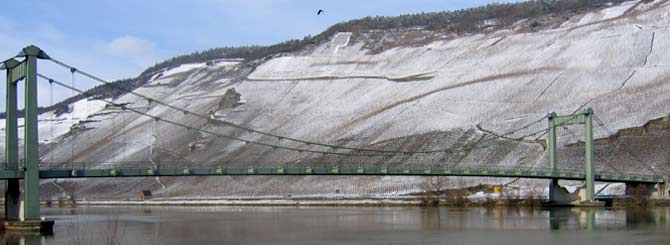
You can see just how incredibly steep the vineyards of the Mosel can be and how dominant the slate rock is, often driving the root systems meters into the hillside.
The best vineyards of Germany’s Mosel Valley are incredibly steep, south-facing slopes with mineral-rich slate soil and a favourable position near the river. Excellent drainage and the heat-retaining quality of the rocky slate soil also help to produce fully ripe, concentrated wines. The combination of these elements results in racy, mineral-inflected Rieslings that are fruity, crisp and very refreshing to drink.
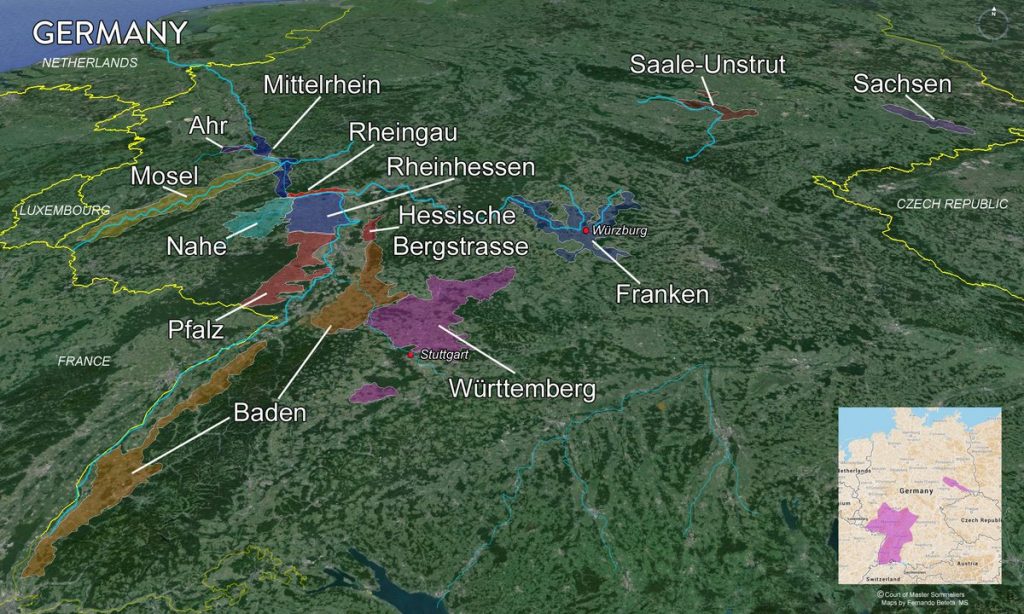
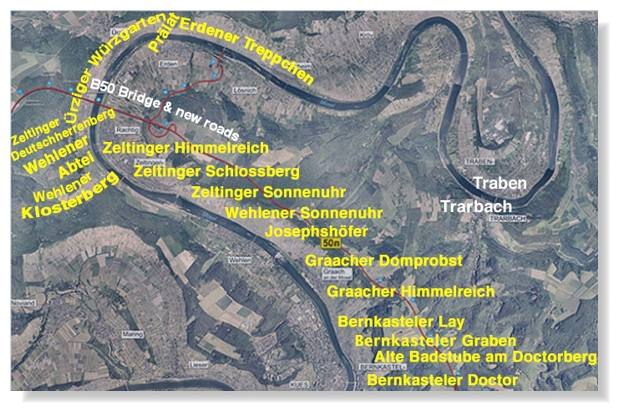
2015 Vintage
Most of the wines in this offer are from the 2015 vintage with a few special museum releases from 2012, 2009, 2002 and 1998 thrown in the mix. It would be fair to say that 2015 is a kind of first among equals. Never before have we (or the Prüm family) seen a vintage with both such power and depth (brought on by the very warm July and August), and yet such bracing freshness and purity (ensured by the very cold September).
JJ Prüm’s Report
A mild winter, changing weather conditions in spring, a hot summer, followed by a cool and rather rainy September and then excellent harvest conditions in October resulted in an intriguing, very promising vintage! After a very mild winter, bud break took place in the second half of April, slightly earlier than the long-term average.
May and June both brought remarkable fluctuations in temperatures – in May from below 5°C (40° Fahrenheit) at the beginning of the month up to 28°C (above 80° F) in mid May back to below 5° C later that month, and then in June between 8°C (45°F) and 33°C (above 90° F). However, while May overall was a dry month, June had 10% more rain than the long-term average, preparing the soils with good humidity for sunshine and hot temperatures during the months of July and early August.
Temperatures then constantly dropped and September was even cooler than the long-term average. The cooler temperatures were helpful during the rainy periods in this month, preventing them from severe rot.
Very luckily, October was not only slightly cooler but also much drier than average, providing excellent harvest conditions.
We slowly started harvest in early October and finished on 4th November.
Being very blessed by nature, we were able to harvest all Prädikat levels from Kabinett to TBA, excluding Eiswein.
Early tastings were very promising – the vintage’s charm, with fine fruit aromas and flavours, paired with its refreshing acidity, impressed us quite remarkably. The latter is particularly noteworthy: After the hot weeks in mid-summer we had expected more moderate acidity levels – and must weights rocketing more upwards than they finally did. How blessed were we not only to harvest the top Prädikate but the “full range” from Kabinett to TBA
Preparing a Prüm Wine to Drink
Prüm’s winemaking often results in a burnt match aroma in young wines and wines just opened. As the wines age the character tends to dissipate. If you’re drinking a young Prüm it’s worth making sure you have time to allow it to breath in glass or to decant on openning if necessary.
About the Wines
The Graacher Himmelreich Vineyards
Graacher Himmelreich directly borders the southern edge of the Wehlener Sonnenuhr vineyard. The wines from this site often often challenge those from its more famous neighbor, especially in hot, dry years. Graacher wines attract with their racy acidity, a pronounced minerality (that reminds of crushed rock) and slightly different fruit aromas and flavours (more in the citrus spectrum). Often, the wines become accessible slightly earlier than the Wehlener Sonnenuhr and are deliciously mouth-watering when young. Looking at the vineyard conditions, the hill faces slightly more westwards than the Wehlener Sonnenuhr , i.e. it has a more south-west exposure, it is a little less steep and has deeper soils which act as excellent water reservoirs.
JJ Prum Graacher Himmelreich Riesling Spatlese 2015
This was the first - among very few - wines in the 2015 Prüm lineup to lead with a bit of yeasty fermentative "Mosel stink," but that veil soon parted more than sufficiently to showcase an alliance of ripe honeydew melon with cassis, grapefruit, and hints of cress and lemon peel that subsequently lend incisive, piquant invigoration on a delicate, polished, infectiously juicy palate. Penetrating and sharply focused, but without its efficacious and enlivening acids turning at all aggressive, the tinglingly, refreshingly citric yet soothing and cooling finish serves up a shimmering array of stony, smoky, alkaline and crystalline nuances.
A great spätlese that is really ripe, but still vibrant, elegant and subtle. Sensational interplay of all the components that make this a very classic example of this category. This has a personality all of its own (something floral that's unusual for this site). No need to hurry before 2050!
Riper, sweeter German rieslings from Mosel are naturally low in alcohol, and their superb delicacy and fragrance are seductive. This spatlese has subtle apple, citrus and blossom aromas with a lovely honeyed overlay. Light and fine in the mouth, it finishes long, zippy and aromatic.
JJ Prum Graacher Himmelreich Riesling-Auslese 2015
Does not smell remotely sweet. Freshly squeezed lemon. And so much lemon on the palate that it tastes, at this stage, more deep cleansing than dessert. Icy ground rocks and lemon peel and monastic severity for an Auslese. Linear. Ignoring everyone. Stern beauty.
Fresh lemon, grapefruit, quince preserves and crème de cassis combine for an attention-getting nose and a polished, rich, but insistently bright and juicy palate. The freshness and invigorating tang of citrus and apple are rare for an Auslese, but quince jelly and candied citrus peels simultaneously project confitured concentration. The seductively luscious finish is more soothing and less dynamic than that of the remarkable corresponding Spätlese, but even longer.
Quite closed on the nose, but this is already gorgeous on the palate. The myriad ripe fruits are so precisely delineated, the acidity so vital and urgent that if you drink it now you'd still be stunned in spite of missing some of the riches it has to offer. Everything is perfectly in place, and the finish is literally breathtaking.
Museum Wines from the Graacher Himmelreich Vineyard
JJ Prum Graacher Himmelreich Riesling Spatlese 2009
That special J J Prüm scent is beginning to find its equilibrium. The customary herbaceous note has mellowed into a gently minty and fumy composition to add complexity to the fragrance of ripe local fruit. There is nothing ostentatious about the nose, but the palate is still very tactile, almost astringent with minerality, adding quite a bite to the juicy expression of grapefruit and peach.
Pink grapefruit, banana, cassis and lily perfume announce the extreme ripeness of fruit that informed the Prüms' 2009 Graacher Himmelreich Riesling Spätlese. Juicy and extroverted on the palate, it packs a sense of sassy brightness that perfectly compliments any tendency toward extravagant or over-indulgent ripeness. As to your being over-indulgent by drinking some, I'd say, "yes, you would be - fortunately." I see no need to wait for a half dozen years to approach this. On the other hand, if you wait 25, this wine will still be waiting for you and in good shape.
JJ Prum Graacher Himmelreich Riesling Auslese 2012
Graacher in extremis. Like the GH Kabinett, this is so tight yet equally alluring in both depth and earthy personality. The wine’s structure and presence suggest a wine cast from stone, not grapes. There is so much yet to unfold here, the Graacher’s origin is detectable through its smoky, citric, mineral essence, its filigreed elegance and latent horsepower. Pure class.
Apricot pit, lime zest and clove on the nose. The delicate nectarine fruit and creamy texture is held aloft by nutmeg and mineral salts. An element of slate provides spice on the enticing finish of this bright, lively wine.
JJ Prum Graacher Himmelreich Riesling Auslese 2009
This wine has everything we look for in a Prüm Auslese. Great intensity, serious depth of fruit, yet somehow it remains feather-light and extremely bright and fresh. Remarkable balance. 8% alc/vol.
The Prüm 2009 Graacher Himmelreich Riesling Auslese mingles spiced apple, papaya, pink grapefruit, cassis, and white raisin in a lush, creamily-textured, pungently botrytis-tinged performance full-throated from nose through peacock's finishing flourish, and hard to beat for sheer diversity and audacity of fruit... in reality this is a wine that deserves a long time in the cellar and is apt to retain and add to its present virtues over a 30 year period.
Vivid and pure-tasting, with a well-structured array of mineral, peach, citrus and savory spice notes that are tightly wound. Still, this is quite airy, especially on the impeccable finish of lime and nectarine. Best from 2015 through 2038.
JJ Prum Graacher Himmelreich Riesling Eiswein 2002
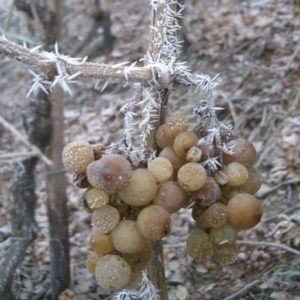 An insanely delicious dessert wine. Picked and pressed while the grapes are frozen, this vibrant, racy dessert wine conjures flavors of densely packed pear, apple and guava, with an intense, nervy edge in the aroma. It is luscious, silky and juicy on the palate, with bright acidity giving it a crisp, dynamic finish.
An insanely delicious dessert wine. Picked and pressed while the grapes are frozen, this vibrant, racy dessert wine conjures flavors of densely packed pear, apple and guava, with an intense, nervy edge in the aroma. It is luscious, silky and juicy on the palate, with bright acidity giving it a crisp, dynamic finish.
Wines from the Bernkasteler Badstube Vineyards
Bernkasteler Badstube is the last of the vineyard sites that can appear on a J.J. Prum label. This vineyard borders those of the Graacher Himmelreich on the latter’s southern edge. The Bernkasteler Badstube slopes are on a marginally shallower gradient, with deeper soils than the Graacher and Wehlener, while the western orientation allows the vines longer exposure to the afternoon sun. The Badstube typically produces a wonderfully floral, delicate and mineral wine. Overall, the wines are usually slightly more delicate in structure and weight when compared with the wines of Graacher or Wehlener but they are wonderfully racy and fine examples of the middle Mosel.
JJ Prum Bernkasteler Badstube Riesling-Auslese 2015
Utterly consistent with the character of the corresponding Kabinett and Spätlese, this projects quince, honeydew, cherry and lime, coolingly and alluringly laced with mint, basil and wintergreen, and wreathed in seductive, lily-like perfume such as one would more likely encounter from Wehlener Sonnenuhr. Certainly this is sweeter than its lower-Prädikat counterparts, but sweetness is not what’s on one’s mind while enjoying it, and there is also liveliness to the fresh, juicy lime component that conveys refreshment rare for an Auslese and pushes back against the wine’s residual sugar.
The overall impression is lusciously sorbet-like. The feel is glossy and slightly viscous but buoyant, and in this respect, too, the sense of citricity is highly efficacious, engendering remarkable liveliness for an Auslese that offsets the wine’s richness. The superbly sustained finish cools and soothes even as it animates and refreshes.
Conjures up images of a tropical garden after rain where everything is dripping. Very delicate in spite of the high ripeness with an almost breathtaking balance of sweetness and acidity that runs right through into the very long finish.
Wines from the Wehlener Sonnenuhr Vineyards
The Wehlener Sonnenuhr vineyard has become intrinsically attached to the name of Joh. Jos. Prüm. The Estate owns five hectares of this majestic site. It offers perfect growing conditions for the Riesling grape with its deep, weather-beaten grey slate soil, good water support, extreme steepness of up to 70 % gradient, and its optimal south-south-west exposure. As for the Zeltinger Sonnenuhr, Wehlener Sonnenuhr is named after the sundial erected in the vineyard in 1842 by Jodocus Prüm, an ancestor of J.J. Prüm, to give the workers a better time orientation. The wines of the Wehlener Sonnenuhr generally possess excellent structure, show beautiful, ripe aromas and flavours (typically stone fruits, like peach, nectarine, apricot), a fine minerality and great depth and length. Especially after having been aged for some years, the harmony, finesse and expression of these wines is unique. Riesling guru Stuart Pigott has written; “Joh Jos Prüm’s Sonnenuhrs are classic examples of the way in which the best Mosel wine’s natural sweetness magnifies, rather than obscures, their character. These are a perfect marriage of Riesling’s peach-like, floral and mineral aspects. White wine cannot be fresher, more vivid and delightful.”
JJ Prum Wehlener Sonnenuhr Riesling Auslese 2015
A whiff of smoke at first, but the nose slowly unfurls. As enormous as it is brilliant, and the interplay of the components is about as sensually ravishing as wine gets. The freshness at the finish is devastatingly beautiful and doesn't want to stop. Better from 2020 and will age for half a century.
Heady scents of lily, heliotrope, quince preserves and apple jelly set the stage for a creamy, buoyant palate performance similarly dominated by billowing floral perfume and rich fruit confiture. Although the harmonious, lusciously layered finish lacks the clarity of the corresponding Zeltinger, it displays superb persistence and incorporates a mouthwatering suffusion of mineral salts. Here is another instance where the Prüms' general observation almost certainly holds true: Wehlener Sonnenuhr needs longer to show its potential than a wine of identical Prädikat from one of their other sites.
JJ Prum Wehlener Sonnenuhr Riesling Auslese Goldkapsel 2012
About Prüms Goldkapsel wines: Think of them as limited edition, rather small production lots of the best Auslese of a vintage. They are made from stronger selected grapes containing higher concentrated juice, usually affected by a certain amount of botrytis / noble rot, capable of aging even remarkably longer than “basic” Auslesen, lasting for many decades. In the course of time, they lose some of their sweetness, gain more and more elegance and harmony and the complex profile and depth come to the forefront.
Rich golden yellow. Heady aromas of strawberry and nut oils, with only a gentle hint of honeyed botrytis. White peach fruit essences and mineral salts animate the creamily rich yet delicate palate. More concentrated than the other ausleses and showing a distinctly aristocratic personality. One of the most impressive ausleses of the vintage.
Intense honey nose. Very firm indeed with vibrato. A special smoked meat and honey production. Not as small a quantity as they originally expected. Picked late November when botrytis suddenly appeared. So delicate and so sweet! Lychee.
Museum Wines from the Wehlener Sonnenuhr Vineyard
JJ Prum Wehlener Sonnenuhr Riesling Eiswein 1998
 An insanely delicious dessert wine. Picked and pressed while the grapes are frozen, this vibrant, racy dessert wine conjures flavors of densely packed pear, apple and guava, with an intense, nervy edge in the aroma. It is luscious, silky and juicy on the palate, with bright acidity giving it a crisp, dynamic finish.
An insanely delicious dessert wine. Picked and pressed while the grapes are frozen, this vibrant, racy dessert wine conjures flavors of densely packed pear, apple and guava, with an intense, nervy edge in the aroma. It is luscious, silky and juicy on the palate, with bright acidity giving it a crisp, dynamic finish.
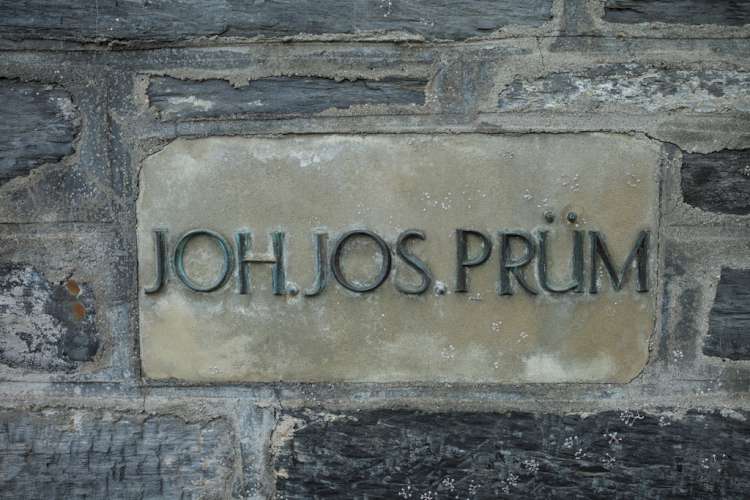
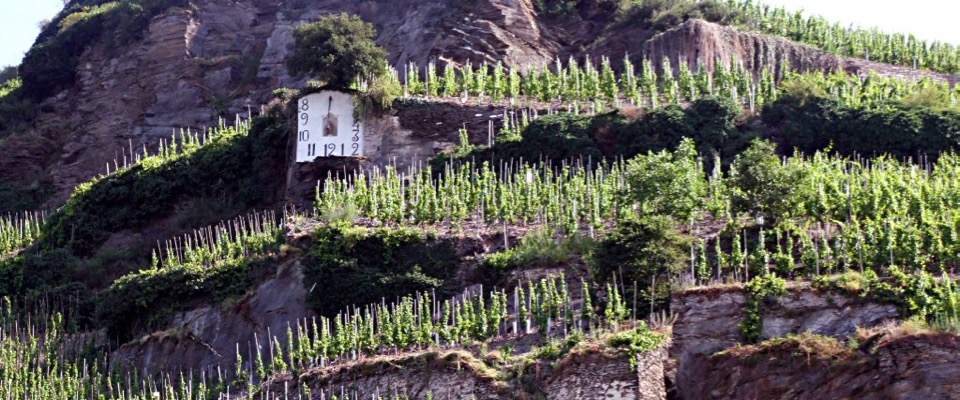
You must be logged in to post a comment.